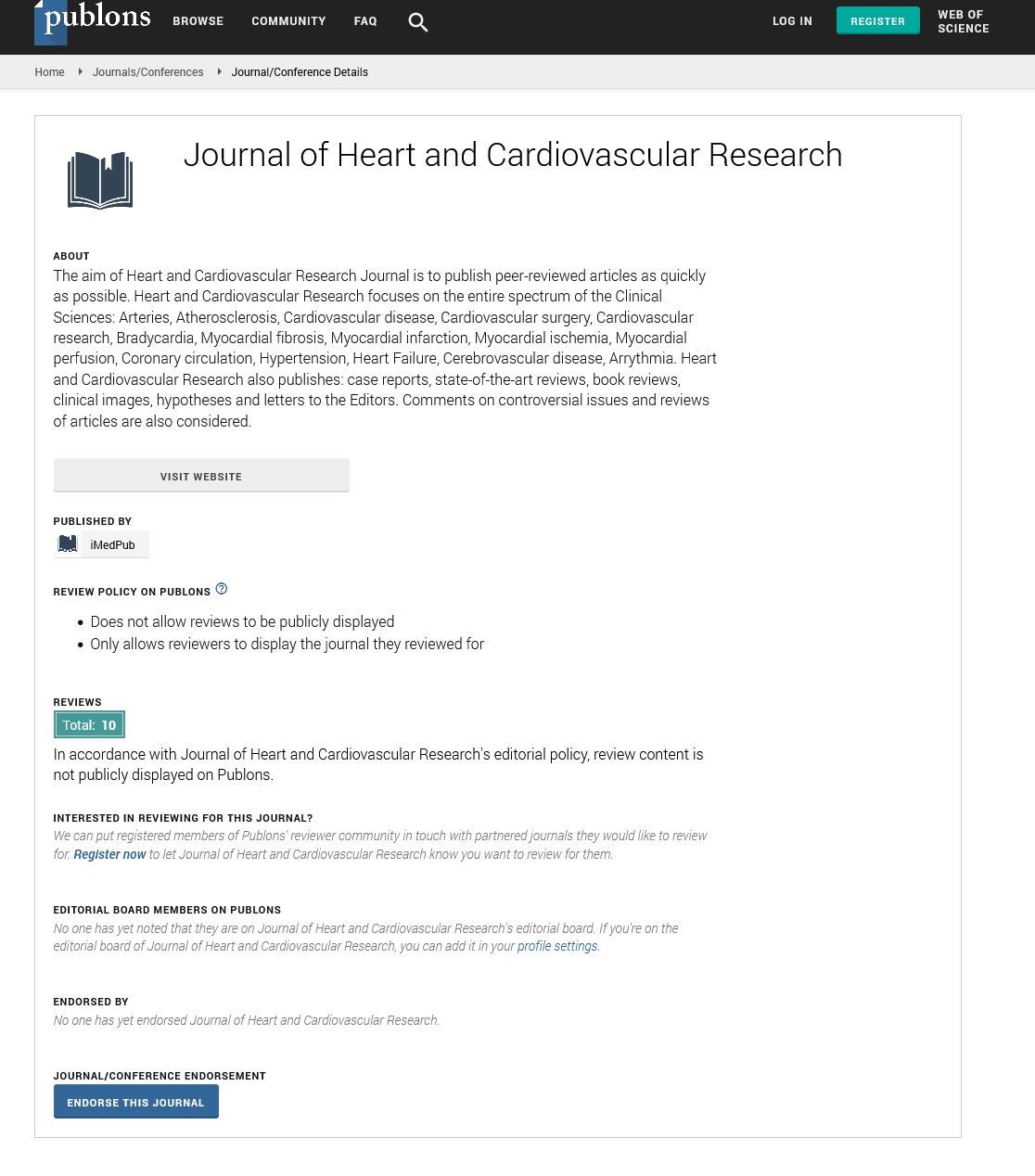ISSN : ISSN: 2576-1455
Journal of Heart and Cardiovascular Research
Abstract
Heart Congress 2018: Pathogenic gene expression of epicardial adipose tissue in CAD patients - Anagha Sahasrabuddhe - NKP Salve Institute of Medical Sciences
Background:CAD is a leading cause of mortality and morbidity world-wide. Epicardial adipose tissue is unique visceral fat depot due to its anatomical and functional contiguity with myocardium and coronaries. Though under physiological conditions, it exhibits metabolic, biochemical and thermogenic cardioprotective properties; in pathological conditions it can exert vasocrine and paracrine actions through its pro-inflammatory cytokines on myocardium and coronaries. Though role of inflammation in development of CAD is well documented, the special role played by epicardial adipose tissue is poorly understood and less studied. Plasma inflammatory biomarkers may not adequately reflect this local tissue inflammation.Cardiovascular disease (CVD) and its sequelae are the leading cause of premature death, leading not only to significantly increased mortality rates but also to high levels of morbidity. Whilst the causes of CVD are complex there is increasing evidence suggesting an integral role for inflammation in CVD pathogenesis, with recent research examining therapeutics targeting this aspect of the disease. However, the cause of inflammation and its link with CVD is still poorly understood, particularly in humans, due to the difficulty in studying the relevant human tissues.Previous studies have highlighted the potential importance of adipose tissue in relation to inflammatory burden in CVD, describing the expression and secretion of both pro-inflammatory and protective factors, collectively termed adipocytokines . These factors include tumour necrosis factor alpha (TNF-α), a pluripotent cytokine that is a key mediator of the acute phase response that also affects non-esterified fatty acid (NEFA) metabolism, as well as myocardial contractility . Resistin, a recently identified adipocytokine, has been proposed as a potential link between obesity and inflammation and has been linked to CVD risk . Adiponectin exhibits both insulin sensitising, anti-inflammatory and anti-atherogenic properties with serum levels reduced in both type 2 diabetes mellitus (T2DM) and coronary artery disease (CAD). Kawanami et al have described directly reciprocal effects of resistin and adiponectin with regard to inflammation in vascular endothelial cells. Adipose tissue also produces further pathogenic adipocytokines including plasminogen activator inhibitor-1 (PAI-1) and angiotensin II (ANG II), the active metabolite of angiotensinogen (AGT), both important in the fibrinolytic and thrombotic pathways . Adipose tissue increases the production of these pathogenic adipocytokines in obesity and it is hypothesised that macrophage recruitment into adipose tissue may contribute to this pathogenic response.
Aims: To find out the pathologic functioning of epicardial fat in patients with CAD and the difference in gene expression of epicardial fat in CAD and non-CAD patients.
Materials & Methods: After obtaining Ethics Committee clearance 27 patients undergoing CABG, and 16 Controls (non- CAD patients undergoing valvular heart surgeries) were recruited in the project. Epicardial adipose tissue sample was obtained and gene expression of following molecules was studied by TaqMan real-time reverse transcription–polymerase chain reaction (mRNA): UCP1, MCP-1, Adiponectin, ADORA, VCAM and TNF-alpha. Fasting blood sugar, insulin, lipid profile, hsCRP, Homocysteine, Vitamin D, vitamin B12, TNF-alpha and Leptin levels were also measured. Results: TNF-alpha, MCP-1, VCAM-1 were found to be up-regulated while the expression of UCP-1, ADORA and adiponectin were down-regulated in cases as compared with controls. After applying multivariate analysis for gene expression, up-regulation of MCP-1 was found to be statistically significant (p= 0.01). Vitamin D levels were low across the groups and there was no difference in the levels of vitamin D, vitamin B12, hsCRP, Homocysteine and TNF-alpha. Leptin levels were significantly high in cases (p=0.018). Conclusion: Epicardial adipose tissue gene expression is significantly pathogenic in CAD patients with upregulation of inflammatory markers and downregulation of anti-inflammatory ones. Plasma levels of inflammatory markers may not be predictive of CAD risk.lowering blood pressure by 7.16 mmHg for SBP and 4.93 mmHg for DBP in hypertensive patients, irrespective of age, duration of disease, physical activity and drug consumption (p<0.05). Physical activity programs with moderate intensity (approximately at 60% MHR), four days per week can be used not only as a preventive measure for diastolic hypertension (DBP>90 mmHg high blood pressure), but as an alternative to drug therapy in the treatment of hypertension, as well. Aerobic exercise is able to produce reductions in hypertensive patients. Recent findings suggest that a modification of dietary and fitness habits are helpful in the prevention or the control of high blood pressure. Previous studies showed that patients with hypertension managed to reduce their blood pressure by about 6-10 mmHg through physical activity. These results are similar
Author(s): Anagha Sahasrabuddhe
Abstract | PDF
Share This Article
Google Scholar citation report
Citations : 34
Journal of Heart and Cardiovascular Research received 34 citations as per Google Scholar report
Journal of Heart and Cardiovascular Research peer review process verified at publons
Abstracted/Indexed in
- Google Scholar
- Sherpa Romeo
- China National Knowledge Infrastructure (CNKI)
- Publons
Open Access Journals
- Aquaculture & Veterinary Science
- Chemistry & Chemical Sciences
- Clinical Sciences
- Engineering
- General Science
- Genetics & Molecular Biology
- Health Care & Nursing
- Immunology & Microbiology
- Materials Science
- Mathematics & Physics
- Medical Sciences
- Neurology & Psychiatry
- Oncology & Cancer Science
- Pharmaceutical Sciences
